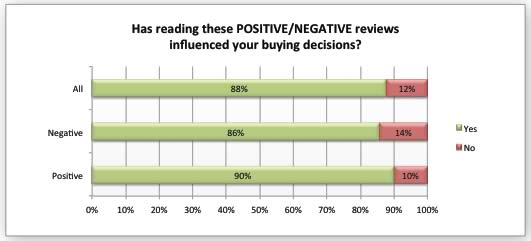Why Great Reviews Aren’t Always Great for Sales
Five stars are wonderful, until they aren't

Is there a situation where great reviews of your product or service could reduce trust and hurt sales? (Looking for ways to improve CX with fun and surprising science? Check out customer experience keynote speaker Roger Dooley.)
There’s little doubt that good reviews normally help build trust. One recent survey from software review company GetApp showed that for a third of the consumers, reviews were the most important factor in their trust of a website. This easily outpaced other factors like secure browsing and ease of contacting the company.

To underscore the point, a Zendesk survey showed a remarkable 90% of customers reported that their purchases were influenced by positive reviews.

Conversion studies bear out the positive effect of reviews. Bazaarvoice, a company that implements review systems, reported that a swimwear ecommerce site, FigLeaves, saw a 12.5% higher conversion rate for products that had reviews vs. those that didn’t. Products that had 20+ reviews converted 84% better. (Note that this is correlation, not causation. It’s possible that more attractive products both converted better and drew more reviews.)

Study: Products with reviews sold as much as 85% more vs. those w/o reviews. #CRO #Neuromarketing Click To Tweet
With data like this in hand, it’s logical that most businesses strive to get positive reviews. And, by and large, that’s a good idea. But, there are a few situations where you can have too much of a good thing.
Uniformly positive reviews reduce trust
Have you ever visited an ecommerce site and found that all the reviewers loved all the products? Did you find the overwhelming positivity a bit suspicious? If so, you aren’t alone.
According to Reevoo, which helps businesses get reviews and feedback, fully 95% of consumers suspect censorship or fake reviews when there are no bad ones.
95% of consumers suspect censorship or fake reviews when there are no bad ones. #Neuromarketing Click To Tweet
The same report also showed that consumers interacting with bad reviews spent five times as much time on a website as those that didn’t, and that those customers converted at an 85% higher rate.
While a preponderance of bad reviews will tank sales for a product, it seems that at least a few bad reviews create an impression of honesty and increase trust.
Furthermore, a bad review that includes the reason for not liking the product helps customers make decisions. Say, for example, that I’m thinking about buying a camera because of its amazing zoom lens. If so, bad reviews of the zoom feature will help me avoid a poor buying decision. It will also avoid a potential return for the seller. But, a few bad reviews that criticize features I find unimportant may increase my confidence that the product will work for me.
High expectations lead to high returns
I’m a big advocate of setting high expectations for a product, as that can actually improve a customer’s experience if the product plausibly delivers on those expectations. People actually experience a better wine if they think it cost more. Of course, that only works if the wine doesn’t taste horrible. No pre-set expectation can overcome an experience that is actually bad.
A study that analyzed over 600,000 ecommerce purchases found that products with all good reviews and no bad ones sold better but also had a higher return rate. The costs associated with product returns, the researchers concluded, offset any increase in profits from higher sales.
The good side of bad reviews: smaller % of purchases are returned, saving money. #Neuromarketing Click To Tweet
Products that had negative reviews that accurately reflected product performance had a lower return rate. The paper recommends that sellers solicit accurate and informative reviews to maximize sales while minimizing returns.
These findings echo an earlier study at Boston University, which found that returns were lowest when there was a large number of reviews. Many reviews flagged as “helpful” led to the best buying decisions (as indicated by low return rates).
Best Review Strategy: Quantity, Detail, Balance
These and other studies suggest that an online retailer should have several review-related goals to maximize revenue and profits:
Quantity. More reviews are almost always better. Customers will have greater trust and more data to help them make a wise decison. Encourage customers to leave reviews, make it easy, and send reminders after the product is received.
Detail. 5-star ratings and reviews with little or no text (“Great product!”) are mostly unhelpful and may seem faked. Reviews with lots of detail are both more credible and more useful in evaluating the product.
Amazon encourages review detail in multiple ways. In addition to the star rating, they require headline and text fields. They allow photos and videos to accompany reviews. And, they let other customers flag reviews as helpful and make comments on reviews. By default, the most helpful reviews are displayed first.
Another way to collect helpful detail is by standardizing ratings in specific features. Travel sites, for example, can let customers rate hotels for things like “location,” “cleanliness,” “wifi quality,” etc. This detail helps new customers make wise choices. A business traveler needing to finish a big proposal won’t choose a hotel that has terrible wifi ratings, nor will the tourist without transportation book a hotel whose location is rated “poor.” Overall satisfaction goes up for the booking site and the hotels themselves.
Balance. The data shows it’s important to resist the temptation to censor or delete bad reviews. The absence of bad reviews reduces trust and can result in lower sales.
To increase #ecommerce sales, encourage honest and plentiful customer reviews. #CRO #Neuromarketing Click To Tweet
When Amazon first allowed customers to post reviews of books, the publishers were aghast. What if people said bad things about their products? In most cases, of course, good books get mostly good reviews and sell fine. But, the presence of reviews hinders a company’s ability to foist bad products on unsuspecting consumers using slick marketing. (Most would call that a good thing.) If your product is getting more than a few bad reviews, it’s a lot more important to fix the product than to manipulate the reviews.
Overall, honest reviews are a boon to both consumers and ethical sellers. Strive for 5-star ratings, but recognize that a 4.7 rating may well be better for business.
A 4.7 rating may sell more product than a perfect 5 stars. #ecommerce #CRO #Neuromarketing Click To Tweet

Roger, this is gold. Keep ’em coming!
It’s always to have mixture of reviews. Having just the 5 star ones, especially if you have 100+ always looks suspicious. It’s impossible to make anyone happy:)
Great points Roger! Honestly I did not think much of this article when I saw the headline, which was compelling, I must concede but I was sure that this was one of those attention grabbing headlines but the content was equally compelling and really you make so much sense! a highly reviewed product could have a higher return rate.
On the other hand you might have mean competitors flooding your website with negative reviews, or creating their own where they will “collect” comments from unsatisfied customers and try their best to let you sink. I’d suggest moderating comments once in a while.